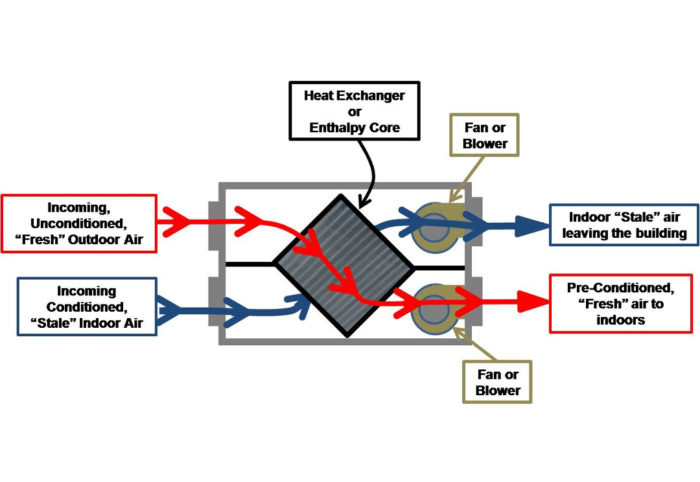10 Essential Reasons Why HRV Boosts Home Sustainability
Wiki Article
Just How Heat Recovery Ventilation Enhances Indoor Air Quality and Reduces Energy Prices
Heat Recovery Ventilation (HRV) systems play an essential function in boosting indoor air high quality while all at once lowering power expenditures. By efficiently trading stagnant interior air with fresh outdoor air, HRVs aid preserve excellent humidity and lower toxins. In addition, their capacity to recover warmth from outgoing air lessens the stress on home heating and cooling down systems. As power expenses continue to rise, comprehending the full capacity of HRV systems becomes progressively essential for property owners and organizations alike.Recognizing Heat Recovery Ventilation Systems

Heat recovery ventilation (HRV) systems play an important function in enhancing indoor air quality, especially in modern, energy-efficient structures. These systems are developed to move warmth from the outward bound stagnant air to the inbound fresh air, consequently lessening power loss while maintaining optimal temperature levels inside. HRVs include a warm exchanger, fans, and ductwork, helping with the constant flow of air. By removing indoor toxins and introducing fresh air, HRVs help to balance humidity degrees, stop mold development, and minimize allergens. The efficiency of HRV systems depends on their ability to recoup up to 80% of the heat from the exhausted air, promoting power conservation while making sure a healthy interior setting. Their combination is crucial in attaining sustainable living practices.
The Importance of Indoor Air High Quality
Indoor air quality (IAQ) is a critical factor influencing the health and health of occupants in any type of atmosphere. Poor IAQ can lead to various wellness concerns, consisting of respiratory system troubles, allergies, and tiredness. Furthermore, it can exacerbate current problems such as bronchial asthma. Variables adding to low IAQ consist of toxins from indoor sources like cleansing representatives, mold and mildew, and poor ventilation. As a result, preserving excellent IAQ is crucial for advertising a safe and comfortable living or working space. Efficient methods to enhance IAQ involve routine surveillance of air high quality, correct air flow systems, and lessening the use of damaging compounds inside your home. By prioritizing IAQ, individuals can assure a healthier atmosphere that promotes performance and general lifestyle.Power Effectiveness Conveniences of HRV Solutions
Many property owners and structure managers are increasingly acknowledging the power effectiveness advantages of warm healing air flow (HRV) systems. By moving warm from exhausted indoor air to incoming fresh air, HRV systems markedly reduce the energy needed for cooling and heating. This process reduces dependence on conventional heating and cooling systems, bring about lower power costs. Furthermore, HRVs assist preserve a well balanced interior climate, protecting against excessive heating or cooling demands. The ability to recoup up to 90% of the warmth from outward bound air also sustains sustainability initiatives by reducing total power intake. Consequently, HRV systems contribute not just to cost savings however likewise to a reduced carbon impact, aligning with the growing emphasis on energy-efficient structure techniques.Installation and Maintenance Considerations
The reliable application of warm healing ventilation (HRV) systems calls for why not find out more careful consideration of installment and maintenance elements to ensure peak performance. Appropriate positioning of the HRV unit is vital, as it should be mounted in an area that optimizes air movement while reducing sound disturbance. In addition, ductwork must be suitably sized and insulated to stop energy loss. Regular maintenance, consisting of filter substitute and system cleaning, is important to secure optimal functionality and interior air high quality. Owners should develop a normal upkeep schedule to recognize and resolve possible concerns before they rise. Collaboration with seasoned experts during both installment and maintenance stages can enhance the durability and effectiveness of HRV systems, inevitably bring about better interior atmospheres and lowered power expenses.
Real-World Applications and Success Stories
Checking out real-world applications of heat healing ventilation (HRV) systems exposes their significant influence on indoor air quality and power efficiency across different settings. In household structures, house owners have reported improved air top quality, leading to less allergies and breathing concerns. Schools carrying out HRV systems have kept in mind boosted pupil focus and lowered absenteeism as a result of much better ventilation. Industrial buildings, such as workplaces and retail areas, have actually experienced lower energy costs and enhanced worker performance. A company workplace in a warm environment accomplished a 30% reduction in energy costs after mounting an HRV system. These success tales show that HRV technology not only contributes to much healthier atmospheres but likewise offers substantial economic advantages, making it click here for more an important investment for numerous fields.Often Asked Concerns
Can HRV Solutions Reduce Irritants in Indoor Air?
The efficiency of HRV systems in lowering indoor allergens mainly depends upon their capacity to filter and exchange air. HRV Heat Recovery Ventilation. By continuously changing stagnant air, these systems can substantially lower irritant degrees throughout indoor atmospheres
Exactly How Does Moisture Affect HRV System Performance?
Moisture considerably influences HRV system efficiency; high levels can bring about condensation, decreasing efficiency, while low humidity may boost air exchange. Stabilizing humidity is crucial for perfect operation and maintaining interior air high quality.a knockout post
Are HRV Systems Noisy Throughout Procedure?
HRV systems can produce differing sound degrees during operation, relying on their layout and setup. Some systems operate silently, while others may create obvious noise, especially at greater airflow settings or when poorly maintained.What Is the Ordinary Life Expectancy of an HRV System?

Can HRV Solutions Be Used in All Climates?
HRV systems can be utilized in numerous climates, yet their effectiveness may vary - HRV Heat Recovery Ventilation. In severe temperatures, modifications or additional systems could be necessary to ensure perfect efficiency and comfort while keeping indoor air high qualityReport this wiki page